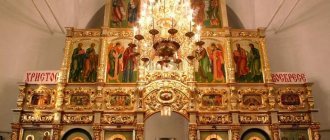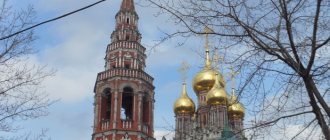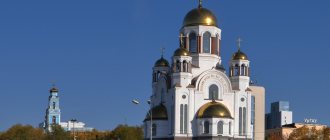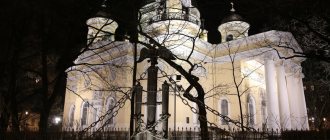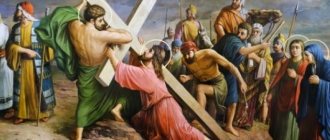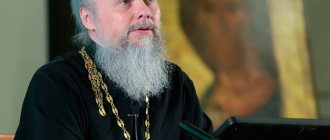History of the construction of the temple
After the free suffering and death on the Cross of our Lord and Savior Jesus Christ, the sacred place of His suffering was trampled upon by the pagans for a long time. When the Roman Emperor Titus conquered Jerusalem in the year, he ravaged the city and destroyed the Temple of Solomon on Mount Moriah, leaving no stone unturned there, as the Savior predicted about this in a conversation with his disciples (Mark 13: 1-2). Later, a zealous pagan, Emperor Hadrian (117-138), built a new city on the site of Jerusalem destroyed by Titus, which he named after Elius-Adrian.
and forbade calling the city by its former name. He ordered the Holy Sepulcher to be covered with earth and stones and placed an idol in that place, and on Golgotha, where the Savior was crucified, in 119 he built a temple dedicated to the goddess Venus. In front of her statue, sacrifices were made to demons and pagan rituals were performed, accompanied by fornication. In Bethlehem, in the place where the Savior was born from the Most Pure Virgin, the wicked king erected an idol of Adonis. He did all this intentionally so that people would completely forget about Christ the Savior and would never again remember the places where He lived, taught, suffered and rose with glory.
When Equal-to-the-Apostles Constantine the Great (306-337), the first of the Roman emperors to recognize the Christian religion, ascended the kingdom, he, together with his pious mother Queen Helena, decided to renew the city of Jerusalem and, at the site of the suffering and Resurrection of the Lord Jesus Christ, to erect a new temple, to cleanse it of bad paganism. places of worship associated with the memory of the Savior, and re-consecrate them all.
The blessed Empress Helena went to Jerusalem with a large amount of gold, and Equal-to-the-Apostles Constantine the Great wrote a letter to Patriarch Macarius I, in which he asked him to assist in every possible way in the holy cause of renewing Christian shrines. Arriving in Jerusalem, the holy Queen Helen destroyed all the idolatrous temples, cleansed the city of pagan idols and sanctified the desecrated places. She was eager to find the Cross of our Lord Jesus Christ and ordered to excavate the place where the Temple of Venus stood. There the buried Holy Sepulcher and the Place of Execution were discovered, not far from which three crosses and nails were found. To determine which of the three crosses belonged to the Savior, Patriarch Macarius ordered that the crosses be laid one by one on the deceased, who was carried past to the burial place. As soon as the Cross of Christ touched the deceased, he immediately came to life. In the greatest joy, the blessed Queen Helen and Patriarch Macarius raised the Life-Giving Cross high and showed It to all the standing people. For more information about this event, see the article The Exaltation of the Holy Cross.
The holy queen immediately began building a large temple, which included within its walls the site of the Savior’s crucifixion—Golgotha and the Holy Sepulcher, which were located a short distance from each other. The Church of the Resurrection took 10 years to build, and Holy Queen Helen did not live to see the completion of construction, reposing in 327. During her stay in Jerusalem, the blessed queen built temples in Bethlehem, on the Mount of Olives, in Gethsemane and in many other places associated with the life of the Savior and the events of the Old Testament.
The completion of the construction of the New Testament Church of the Resurrection of Christ, called “Martirion”, in memory of the Savior’s Passion on the Cross, coincided with the First Council of Tire and the thirtieth anniversary of the reign of Equal-to-the-Apostles Emperor Constantine the Great. Therefore, the consecration of the Church of the Resurrection, which took place on September 13, 335, was especially solemn. Hierarchs from many lands took part in the consecration of the temple: Bithynia, Thrace, Cilicia, Cappadocia, Syria, Mesopotamia, Phenicia, Gravia, Palestine, Egypt. The fathers of the just ended Council of Tire were invited to the celebration of renewal. On the same day the entire city of Jerusalem was consecrated. The memory of this significant event was established by the Fathers of the Church on September 13.
Exodus and its celebration
The word “Easter” itself (Hebrew – “Passover”) comes from the verb “to pass” with the meaning “to deliver”, “to spare”. Passover is a real historical event that occurred in Egypt in the 13th century BC, when, according to Tradition, the Angel of the Lord passed by Jewish houses sprinkled with the blood of a sacrificial lamb and struck with death all the Egyptian firstborns. The fact is that for several centuries before this event, the Jewish people were enslaved by the Egyptians. Pharaoh responded to repeated requests from the Israelites to let them go with an invariable refusal. During the last decades of slavery, their situation worsened significantly. The Egyptian authorities, concerned about the “excessive” number of Jews, ordered the death of all boys born to them. The leader of the Israeli people, the prophet Moses, at the command of God, tried to reason with the stubborn Pharaoh and achieve liberation. The so-called “10 Egyptian plagues” are associated with this, when all of Egypt (except for the place where the Jews lived) suffered in turn from the invasion of toads, midges, poisonous flies, locusts, pestilence, etc. These were clear signs of God's presence among the Jews, but Pharaoh did not give up and did not release free labor. Then the last, tenth plague occurred in Egypt. God, through Moses, commanded each Jewish family to slaughter a lamb (one-year-old lamb or male goat), bake it, and eat it with unleavened bread and bitter herbs. The meal took place in the evening; it was necessary to eat standing and with great haste, because God promised that the Jews would leave Egypt at night. You should anoint the doorpost of your home with the blood of the lamb. This was a sign for the angel who killed all the firstborn of Egypt, from the firstborn of Pharaoh's family to the firstborn of the cattle, but passed by those houses whose doors were anointed with the blood of the lamb.
Christ in the form of a lamb.
Syanovsky quarries After this execution, the frightened Pharaoh released the Jews from Egypt that same night. Since then, Passover has been celebrated by the Israelis as the day of deliverance from Egyptian slavery and the salvation of all Jewish firstborns from death. However, the celebration took place not one day, but seven. Every devout Jew had to spend these days in Jerusalem. During the holiday, all leavened products were taken out of the houses, and only unleavened bread (matzo) was eaten, in memory of the fact that the Jews’ exit from Egypt was so hasty that they did not have time to leaven the bread and took with them only unleavened flatbread. Hence the second name of Passover - the Feast of Unleavened Bread. Each family brought a lamb to the Temple, which was slaughtered there according to a ritual specially described in the Law of Moses. According to the Jewish historian Josephus, on the Passover of 70 A.D., 265,500 lambs were slaughtered in the Temple in Jerusalem. Perhaps this figure is greatly exaggerated, as is often the case with Josephus, but even if we reduce it by several orders of magnitude, the picture of what happened on that day in the Temple is impressive. The family had to bake this lamb, which was called Passover, and be sure to completely eat it in the evening on the first day of the holiday at the Passover meal called Seder. This dinner was the main event of the celebration. Also, the obligatory diet of the Passover meal included bitter herbs (in memory of the bitterness of slavery), charoset (a paste of fruits and nuts) and four glasses of wine. The father of the family was supposed to tell the story of the exodus of the Jews from Egyptian slavery over the meal, both in gratitude to God and as a reminder of the special connection of his people with Him. The Passover meal could only be held in Jerusalem, within its city walls. Therefore, the pilgrims negotiated with local residents, who provided them with free rooms or allowed them to have the Easter meal in the courtyard or on the roof of the house. It was not allowed to take money for the premises, but the owners were usually left with the skins of killed animals as compensation. The poor who had no money received special assistance to purchase everything they needed. In addition, it was considered godly to invite poor brothers to one’s holiday.
The celebration of the Old Testament Passover is described here in the past tense, since with the coming of Christ it loses its meaning, however, without any special changes, the Jews still celebrate Easter in this way. The main difference between the current Jewish Passover is that there is no lamb at the meal. It is symbolized by a ram's bone, because according to the law of Moses, a lamb cannot be slaughtered anywhere except the Temple in Jerusalem, which was destroyed by the Romans in 70 A.D.
Prayers
Troparion, tone 4
As the heavenly firmament has splendor, / and you have shown below the beauty of the holy city of Thy glory, O Lord, establish this forever and ever, / and accept in it our unceasing prayers offered to you by the Mother of God, / for the Life and Resurrection of all.
Kontakion, voice the same
The multi-illuminated sky of the Church has appeared, / all the enlightening faithful, standing in it we call: / establish this house, O Lord.
In Kontakion, voice 2
Grant renewal of the spirit in the hearts / and enlightenment of the inner, / by faith, those who perform the sacred renovation of the temple of Thy house, / which Thou hast deigned to be created / in Thy Divine name, / Who alone is glorified among the saints.
Fulfillment of the Old Testament Passover
Already in the first years of Christianity, the Old Testament Easter was interpreted as a prototype of the death and Resurrection of Jesus Christ. “Behold the Lamb of God, who takes away the sin of the world” (John 1:29). “Our Passover, Christ, was sacrificed for us” (1 Cor 5:7). These words of John the Baptist and the Apostle Paul best express the attitude of Christians towards the Calvary Sacrifice. In Egypt, a lamb was slaughtered in order to save the Jewish firstborn from death, and Christ sacrificed Himself to deliver all humanity from death. And we are not talking about physical death here, because people, as they died before Christ, are dying now, and this will last until His Second Coming in power and glory, when He will resurrect the dead. But after the Resurrection of Christ, physical death is no longer a dead end, but a door. The inevitable end of any person becomes an inevitable condition for his meeting with God. Therefore, by the way, in Christianity, hell and heaven are understood not as places, but as states of a person who is ready or not ready for this meeting.
The Descent of Christ into Hell
The meaning of the New Testament Easter is well expressed in iconography. Now more familiar is the icon of the Resurrection, where Christ stands in shining white robes on a stone rolled away from His tomb. However, until the 16th century, the Orthodox tradition did not know such an image. The festive icon of the Resurrection, which was displayed in the middle of each church, was called “The Descent of Christ into Hell.” On it, Jesus leads the first people (Adam and Eve) out of hell, symbolizing those representatives of humanity who kept the true faith and waited for the Savior. The same thought can be heard in the main Easter hymn: “Christ is risen from the dead, trampling down death by death and giving life (life) to those in the tombs (who died).
The end of the Christmas story
Since then, this day has become the “holiday of holidays” and the “triumph of celebrations,” the center and pinnacle of the whole year. Christians did not spend their days of celebration in carefree fun. It was a time of special feat of charity, visiting almshouses, hospitals and prisons, where, along with the greeting “Christ is Risen!” people brought clothes, food, money. There is a widespread custom of painting eggs for Easter, which people then exchanged, congratulating each other on the holiday and kissing each other three times (“Christed”). According to church tradition, this custom dates back to apostolic times, when Mary Magdalene, who arrived in Rome to preach the Gospel, presented Emperor Tiberius with a gift of a red egg with the greeting “Christ is Risen!” and it was with these words that she began her sermon. The egg serves as a symbol of the coffin and the emergence of life in its very depths, and the red color is a symbol of the blood shed by Christ so that death would pass by. In many European countries, it is traditionally believed that the main Christian holiday is Christmas. However, in Orthodoxy the main holiday has always been Easter. Why? Back in the 2nd century, Saint Irenaeus of Lyons, answering the question why God became man, said: “God became man so that man could become god.” The Nativity of Jesus Christ is a great event, because God became man. Without the Incarnation, salvation is unthinkable, but this is only the beginning, and in many ways it is not dependent on us. Now it is necessary that any person can become a god. This is exactly what happened in the year 33, on the first day of the week of the 16th day of the first spring month of Nisan in sleeping Jerusalem. And it is repeated every time a person lives and dies with the belief that the dead are resurrected.
